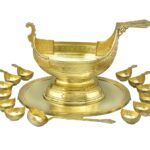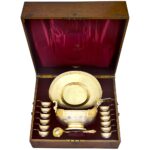Provenance
Rear Admiral of the U.S. Navy Charles Henry Davis, Jr. (1845-1921), gift of the Russian Imperial cabinet
Thence by descent
This set is produced by Grachev Brothers, one of the leading Russian jewellery firms of the latter part of the nineteenth century, a purveyor to the Imperial Court. It comprises a large punch bowl of kovsh form modelled as a stylised Viking longship set on a large oval stand with raised centre together with twelve conforming kovshi and a punch ladle with chased flat handle decorated with geometric design and terminating in a spherical bowl with a pouring lip. The set is contained in the original fitted oak case with dark red satin and velvet interior, the inside cover is stamped with the Grachev firm’s trademark. The exterior of the case’s cover is mounted with a small brass Russian Imperial double-headed eagle.
The set was presented to Rear Admiral of the U.S. Navy Charles Henry Davis, Jr. (1845-1921) by the Russian Imperial cabinet in gratitude for his diplomatic efforts to resolve an incident between Russia and Britain during the Russo-Japanese war (1904-1905).
Charles Henry Davis, Jr. was born in 1845, in Cambridge. His father was also a Rear Admiral (with the same name) in the Navy and had a distinguished career on the high seas. Between 1861-1864, Davis Jr. studied at the US Navy Academy at Newport, Rhode Island. After his graduation he served at various stations and duties, advancing quickly through the ranks, so that by 1905 he was elevated to Rear Admiral. The Admiral got drawn into the sphere of international politics in 1904 with the so called Dogger Bank Incident.
On October 21, 1904, elements of the Russian Baltic Fleet were in the vicinity of Dogger Bank, a sandbank in the North Sea, some 60 miles off the coast of England. Their destination was the Far East, where they were to support their country’s efforts in the ten-month old Russo-Japanese War. A series of mishaps led to a deeply unfortunate event. The Russians’ nerves were made jumpy by erroneous reports of Japanese torpedo boats and submarines in the area and they were under orders to allow no ships of any kind to infiltrate the fleet. The evening of the 21st, the captain of the supply ship Kamchatka mistook a Swedish vessel for a Japanese torpedo boat, and sent a radio message that he was under attack. Later in the evening, mistaking harmless British fishing trawlers for their enemy, the Russians opened fire on a cluster of about 30 civilian boats. Several British sailors perished and still more were wounded; one died of his wounds months later. The British trawler Crane was sunk.
The incident created a major crisis in Russo-British relations: the British were naturally outraged, the Russians were savaged in the British press as pirates, and the Russian naval command was reviled for not even leaving lifeboats for the British upon whom they had mistakenly fired. A war between the two countries was prevented due to US diplomatic efforts undertaken by Admiral Davis. Davis entered a special international commission of enquiry which sat in Paris in February 1905. Only through his patience, delicacy and inspired diplomacy was the situation prevented from escalating worldwide. Davis’s part in resolving the crisis received high acclaim: at home he was commended in Congress and praised by President Roosevelt. The appreciation of the Russian and British Governments were shown to Davis through their respective gifts. Russia’s gift via their Ambassador is very traditional and emblematic of the sea. It epitomises the quality of Russian craftsmanship and is wonderfully presented in the original fitted case. Special dispensation had to be granted from the American Government to enable Davis to accept the gifts and retain them as his personal property.
The firm of Grachev was founded in St.Petersburg in 1866 by silversmith Gavriil Petrovich Grachev. Upon his death in 1873, the business passed on to his numerous sons and became known as the Grachev Brothers. The firm participated in various Russian and international fairs, including a Copenhagen exhibition in 1888 and the Columbian Exposition in Chicago five year later and received prizes. In 1892, twenty nine year old Mikhail Gavrilovich Grachev was named valuer to the Russian Imperial Cabinet; that same year, the firm received the title of Imperial Court Supplier and were permitted to use the Imperial Warrant or double-headed eagle as part of its hallmark. The business closed in March 1918.













